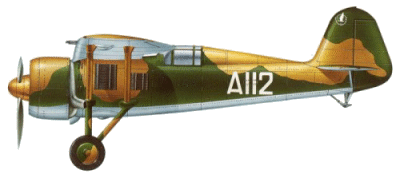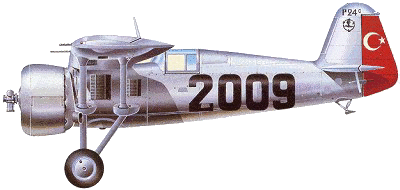
Typical example of a
fighter that marked the transition between the monoplane and the
biplane, the PZL P.24 represented the final stage in the evolution of a
successful series of battle planes developed by Zygmunt Pulawski who,
up to March 1931, was chief designer at Panstwowe Zaklady Lotnicze, the
Polish State aeronautical factory. The founder of the whole series had
been the 1929 P.1 model, which was followed in 1930 and 1931 by the P.7
and the P.11 models.

The P.24 was, in fact,
the natural development of the P.11 model, produced for the foreign
market. The first prototype flew for the first time in May 1933, and,
after much further work, the fighter demonstrated its qualities to the
full on June 26, 1934, when the second prototype, piloted by Captain
Boleslaw Orlinski, touched 257.2 mph (414 km/h) and established an
international speed record for its category. At the Salon
Internationale de l'Aeronautique de Paris (Paris Air Show) in the same
year the PZL P.24 was defined unanimously as the world's fastest and
best armed interceptor.

The entire production
of the P.24 along with nine prototypes, (almost 300 examples of various
versions were completed from spring 1935, about half of them on license
by Turkey and Romania) was destined for export. The other main users of
the plane were Bulgaria and Greece. In 1939, on the eve of the German
invasion, there were orders for a total of 190, and among new buyers
were Estonia, Finland, Hungary, and Yugoslavia.
The great success of
the PZL fighter family was due essentially to the design's originality
and to the plane's excellent overall characteristics. These were
evident right from the appearance of Pulawski's first ever prototype,
the P.1 model, which began flight tests on 25 September 1929. The
fighter was provided with a gull-like wing (with the aim of improving
the pilot's visibility), an all-metal airframe and skin, and fixed
landing gear. It was powered by a 600 hp (448 kW) Hispano-Suiza engine
which guaranteed a maximum speed of over 186 mph (300 km/h) at sea
level. Both its ease of handling and its climbing qualities were
remarkable. The P.1 was presented in 1930, at the Bucharest Air Show
and proved to be superior to some of the best fighters of the day, such
as the French Dewoitine 27, the Dutch Fokker D.XV, and the British
Bristol Bulldog.
However the P.1 never
went into production, since the military authorities insisted on the
use of radial engines. Therefore, two other prototypes were prepared,
the P.6 and the P.7, with the latter (first flight October 1930)
ultimately being chosen. Named the P.7a and provided with a Bristol
Jupiter VIIF engine built on license by Skoda, 150 aircraft were
completed, and they went into service in the second half of 1932.
A year later, the
Polish air force was the first 1n the world to have its front-line
consisting entirely of metallic monoplanes. Unfortunately, Pulawski met
his death in an air accident, on 31 March 1931, and a new designer,
Wsiewolod Jakimiuk, was called to develop the P.7's successor. This was
the P.11 , which made its first flight in September 1931. Modified
structurally, better armed, and provided with a more powerful engine,
the 500 hp (376 kW) Bristol Mercury IVS2 the P.11 went into production
immediately and, in a series of ever-improved versions, 225 planes were
produced by PZL and 70 on license by the Romanian IAR. The Polish air
force was founded in 1934, and at the time of the German invasion 12
fighter squadrons were provided with P.11cs. The 114 that were lost
shot down approximately 120 enemy planes.
The PZL P.24, on the
other hand, saw combat bearing different insignia and was used
especially by the Greek air force in final months of 1940, and at the
beginning of 1941 against Regia Aeronautica (Italian Royal air force)
and the Luftwaffe.

A PZL P.24C of the 4th Regiment, Turkish Air Force based at Kütaha 1939
Variants
PZL P.24/I - Because of
the terms of licence agreements for the manufacture in Poland of
Bristol engines, it was difficult to market export aircraft with P.Z.L.
built versions of these engines. To overcome this difficulty it was
decided in February 1932 to develop a new fighter with different
powerplant, the airframe of the P.Z.L. P.11 being redesigned to accept
a new Gnome-Rhône engine designated 14Kds Mistral Major and rated at
760 hp (567 kW). Availability of the first of these engines delayed
until May 1933 the initial flight of the resulting P.Z.L. P.24/I
prototype, a flight which ended in a forced landing when the propeller
disintegrated.
PZL P.24/II (also Super
P.24) - The P.24/1 did not fly again until October 1933, showing a need
for many modifications which were introduced in the P.24/II second
prototype, this aircraft also being known as the Super P.24. On 28 June
1934 the aircraft established an FAI-accredited class speed record of
414 km/h (257.25 mph).
PZL P.24/III (also
Super P.24bis) - A third prototype flown in 1934, the P.24/111 or Super
P.24bis, was powered by a 930 hp (694 kW) Gnome-Rhône 14Kfs and armed
with two 20 mm cannon and two machine-guns. Exhibited at the 1934 Salon
de I'Aeronautique in Paris, this aircraft caused considerable interest
and led ultimately to valuable export orders.
PZL P.24A - The first
came from Turkey, which not only negotiated a licence for the
manufacture of the P.24, but also ordered 40 P.24A fighters generally
similar to that shown at Paris.
PZL P.24C - 26 P.24C
aircraft with four wing-mounted machine-guns, and components plus raw
materials for the assembly of 20 more P.24As.
PZL P.24B - Next came
an order from Bulgaria for 14 P.24B aircraft which were similar to the
P.24C apart from installed equipment and were delivered from early
1938, followed by 24 P.24Cs and 26 examples of the P.24F.
PZL P.24F - The final
development of the type, which introduced a 970 hp (723 kW) Gnome-Rhône
14N.07 engine of smaller diameter and had twin cannon and twin
machine-gun armament.
PZL P.24E - The P.24E,
developed to meet a Romanian requirement, was generally similar to the
P.24C: six built by P.Z.L. had 900 hp (671 kW) Romanian-built Gnome-Rhône
14Kllc32 engines, but later examples of the 40 or so P.24Es built by
I.A.R. in Romania had the 940 hp (701 kW) I.A.R. built 14KMc36 engines.
PZL P.24G - In late
1939 I.A.R. developed a low-wing version of the P.24E under the
designation I.A.R. 80. The four machine-gun equivalent of the P.24F had
the designation P.24G. and 30 and six respectively were acquired by
Greece for service with the Royal Hellenic air force. They comprised
almost the entire fighter strength of this last air force and were
deployed with considerable success against both the Luftwaffe and Regia
Aeronautica.
Specifications (PZL
P.24F)
Type: Single
Seat Fighter
Design: Zygmunt
Pulawski (Wsiewolod Jakimiuk after Pulawkis died on 31 March 1931)
Manufacturer:
Panstwowe Zaklady Lotnicze in Poland, also built under licence by
Romanian Aeronautical Industry (IAR) and Turkey
Powerplant:
(P.24F) One 970 hp (723 kW) Gnome-Rhône 14N.07 14-cylinder two-row
radial engine.
Performance:
Maximum speed 267 mph (430 km/h) at 14,765 ft (4500 m); service ceiling
34,450 ft (10500 m); climb to 16,405 ft (5000 m) in 5 minutes 40
seconds.
Range: 435 miles
(700 km) on internal fuel.
Weight: Empty
equipped 2,937 lbs (1332 kg) with a maximum take-off weight of 4,409
lbs (2000 kg).
Dimensions: Span
35 ft 1 1/4 in (10.70 m); length 24 ft 11 1/4 in (7.60 m); height 8 ft
10 1/4 in (2.70 m); wing area 192.68 sq ft (17.90 sq m).
Armament: Two 20
mm Oerlikon FF cannon and two 7.7 mm (0.303 in) Browning machine-guns
(700 rounds per gun) or 7.7 mm (0.303 in) KM Wz 33 machine-guns (500
rounds per gun). Could also carry 88 lbs (40 kg) of bombs externally.
Variants:
P.24/I, P.24/II (Super P.24), P.24/III (Super P.24bis), P.24A (Turkey),
P.24C (Turkey), P.24B (Bulgaria), P.24F, P.24E (Romanian), P.24G
(Greece).
Avionics: None.
History: First
flight (prototype) May 1933.
Operators:
Poland, Turkey, Greece, Bulgaria, Romania. |
